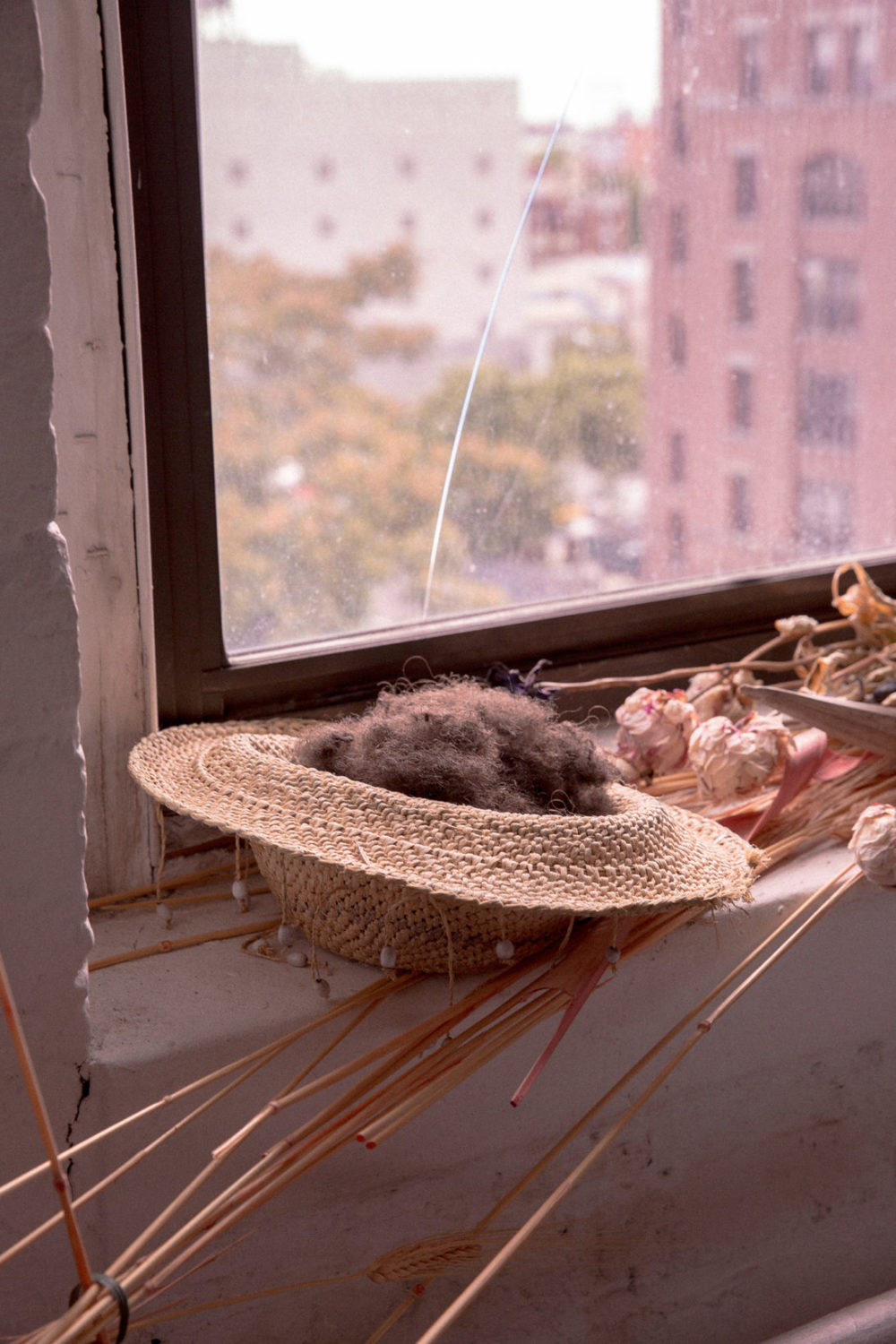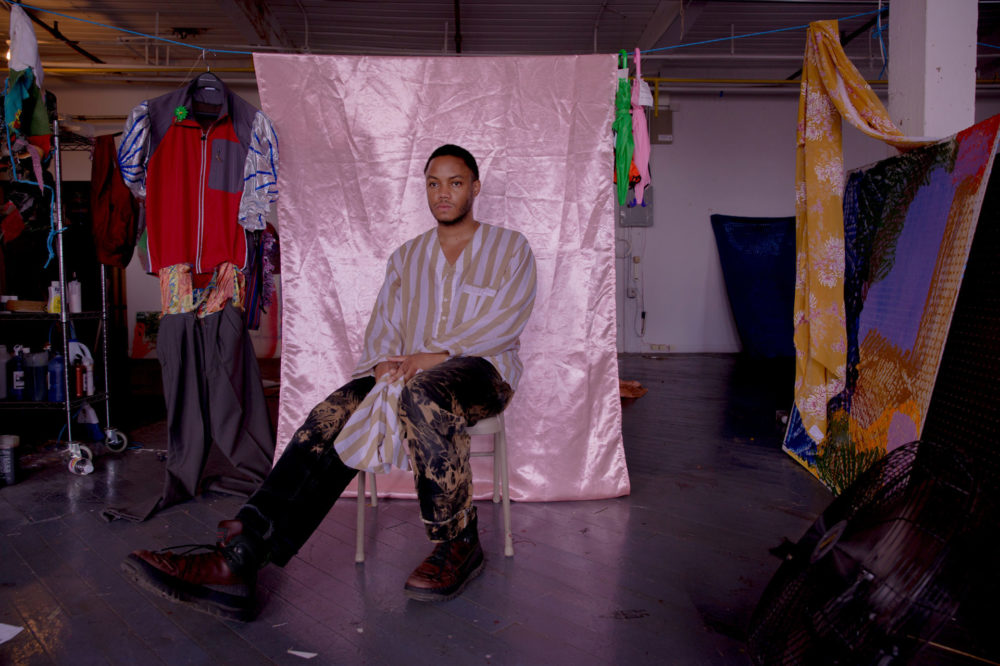The work of Eric N. Mack has all the bizarre, irreconcilable contiguities of a Borgesian list: velour, paint, an image of Mary J. Blige baffled by fame, curtain rods, dye, mattress fragments, a hoodie, a human being, an open umbrella, snatches of early Nicolas Ghesquière, the hauteur of Vivienne Westwood, safety pins, patches of the deepest saturated color, a peplum or a bolero (or neither), and images upon images upon images. To search for meaning in the relay between the elements is to lose oneself in abstraction, as if in a labyrinth. One cannot decipher the code by summing the materials or looking for thematic continuities. The work generates a hum, a vibe. It is received whole, like the sacrament. I am often troubled by the anxiety that there are more materials than I have noticed, more than I am capable of noticing: a small strip of tape, a piece of lint, drops of sweat, something that sits just beyond the reach of my perception.
My first encounter with the artist’s work was during his residency at The Studio Museum in Harlem in 2015. He was attaching found fabric and repurposed clothing to a large steel armature that nearly filled the entire studio. The architectural, even Baroque ambition of the work was evident. There were intimations of an inside and an outside, the ghost of a gabled roof, and an irregular rhythm of slouching apertures suggestive of doors and windows. There was the faintest murmur of the monad, of an effort to construct something as self-contained as a house.
I noticed a worn copy of Gilles Deleuze’s The Fold on the floor, beneath a window that looked out onto 125th Street, onto the long promenade of stalls and awnings held precariously together by the same steel frames that Mack used. I said something facile about Deleuze. The artist generously changed the subject; he had studied him closely and had no time for dilettantes. And yet even now, I suspect that book was a stray fragment of the tower he was erecting in the middle of the room. His work spoke of Deleuze’s fixation with the intersection of infinite, differential, unbounded planes; of rippling curtains, things that coil and uncoil themselves in perpetuity, and materials that gather like shadows. I felt that these planes of fabric continued infinitely beyond the frame of the armature, that he had arrested their tectonic shifts if only for a moment.
In that studio at the onset of his career, Mack was locked in a Babelesque struggle to combine all the formal trajectories of his future work into a single figure, avant la lettre. This is characteristic of writers and their first works. Those who spend their childhood in gifted somnolence and suddenly awaken for the first time, garrulous and steaming, and now have to say everything that’s been held in reserve for so long. In Harold Pinter’s The Birthday Party, he condenses every theme he will take up over the length of his career into a single work: the interrogation, the memory play, the two-man routines of vaudeville, the vagaries of infidelity. When Jay-Z was asked why he had never been able to replicate the virtuosity of his first album, Reasonable Doubt, he replied that it had taken the first 26 years of his life to make it.
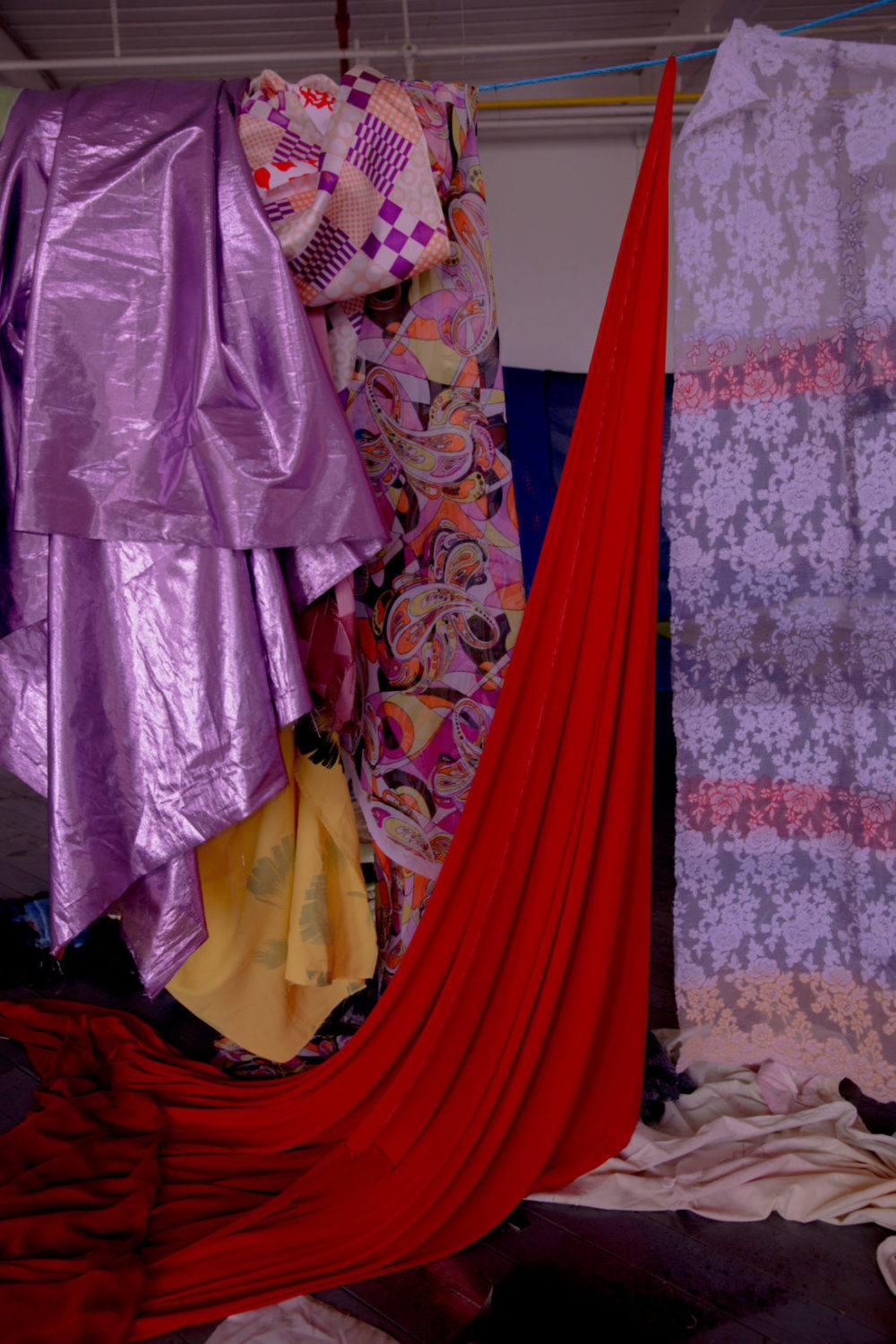
Standing in Mack’s studio, I was reminded of an installation by Greek artist Jannis Kounellis at the 1993 Venice Biennale. In Untitled (1993), Kounellis suspended several large sails beneath a gabled skylight that ran the length of the space. Discolored and worn from years of use, they billowed in the sounds and winds stealing through opened doors. I imagine Kounellis stepping off the train mere days before the soft opening with no idea what to show. I imagine him as he must have been: in bowler hat and tattered waistcoat, closed umbrella with pearl handle in one hand and a doctor’s black satchel in the other. Later that afternoon, he notices several old fishing boats nodding sleepily in the lagoon and sends his assistants down to buy their sails. His instructions are characteristically simple: not too big, not too colorful, and not too many…
As if marshalling the strength of the entire building, he rigs the sails to the steel trusses supporting the ceiling and skylight. He transforms the room into a fishing boat; an elaborate, profligate apparatus for lofting sails. The mystery of the piece lies in an economy of simple gestures—an arrangement of sails and rope—and an extremely rarified and idiosyncratic personal language of metaphor and literary allusion. The work is site-specific because it responds directly to the architectural exigencies of the space in which he placed it; however, crucially, it is of other sites, other places that the work speaks. It is a heterotopia.
It evokes the transportive quality of painting, the strange and ineffable relationship between storytelling and traveling by sea at the heart of all Mediterranean mythological traditions. We witness Kounellis as a child along the Piraeus, watching the sailors at their posts and the crisscrossing lines of drying clothes in the skies overhead. The sails speak of the Homeric catalogue of ships, the suspended contortions of Zurbarán’s The Martyrdom of Saint Serapion (1628), the folds in the martyr’s frock, and the writhing of all martyrs. In a faded image of the crucifixion on one of the sails, Kounellis echoes the veil that Veronica used to wipe Christ’s face and, in turn, the veronica of the bullfight, the twisting body of the bullfighter. The bull itself is there too in the Giardini, hanging like Rembrandt’s Slaughtered Ox (1655), and the bull that seized Europa from that white beach, and the Minotaur sleeping at the heart of the labyrinth. The same Minotaur that Theseus killed with the help of Ariadne, the weaving goddess, and the long thread that he followed back to safety. Even at the beginning of everything, there was sewing, as there is in Kounellis and in Mack. I am left with the sense that art, like all faiths, orients itself around a sacrifice, a vanishing point.
To be sure, many of these observations deal with the peculiar relation between suspended fabric and the body, and yet, it is no stretch to say that all hung fabric evokes the body. To say that the bunched canvases of Sam Gilliam, the tortured skeins of Joe Overstreet, Rauschenberg’s “Jammers” series, or Eva Hesse’s polyurethane casts refer to the body is a completely banal observation. What sets these artists apart from one another is how they discipline those bodies, the control points they select. How they impose form and structure upon a material that resolutely refuses to be controlled and the degree to which they express this tension. For instance, in Overstreet’s work, it is the use of rope and grommets to stretch the fabric almost violently that suggests lynching. The cruelty enacted upon the fabric re-enacts other cruelties, other hangings.
In Mack, there is a language of the suspended pile, of the messy space, of the bodies that leave their traces behind. He does not use the orthogonal rhythms of Rauschenberg to manipulate his material; he sends out lines of play rather than lines of force. He does not use structure to discipline fabric, but rather, it is through his structures that the fundamental indiscipline of fabric is expressed, its refusal to completely obey the dictates of form. Somehow it does what it wants to do. His formal promiscuity allows for structure to altogether disappear. His paintings are suspended from the ceiling, they sit on the floor, hang from the walls. They are superimposed, painted over, folded, creased, cut, pasted and stained.
There is a palpable kinship between Mack’s work and that Kounellis piece in the Giardini. They share that heterotopic quality, the convergence of highly calibrated architectural specificity and the dispersive, vertiginous qualities of literature. His combinations of materials are not collages, nor are they the mere juxtaposition of unlike things squeezed between parentheses, flashes of visual dissonance, or a series of braided non-sequiturs. If anything, Mack’s combinations have more to do with line, composition and color as ends in themselves—qualities more native to abstract painting. And yet still his paintings contain identifiable objects, things which have names and uses that we know. He has both abstract and representational agendas in equal measure, and these do not stand side-by-side as in a Gorky painting, but overlap and intersect. A sutured garment may be reminiscent of a particular silhouette from a Comme des Garçons show in the early aughts, but it may also be painted the hue of a sunset that exists only in the artist’s memory, and in turn, with a certain calligraphic Twombly gesture. The physical tangle of elements mirrors and is productive of a metaphorical tangle. A felt blanket is cut, creased, dyed and folded, first by hand, then many times over in the deep, subterranean streams of personal memory and art historical reference. Following these streams beyond what the work immediately contains into the inexpressible, into the folds of wordless music, as into Proust’s charged madeleine, is one of the pleasurable inevitabilities of all great art and literature.
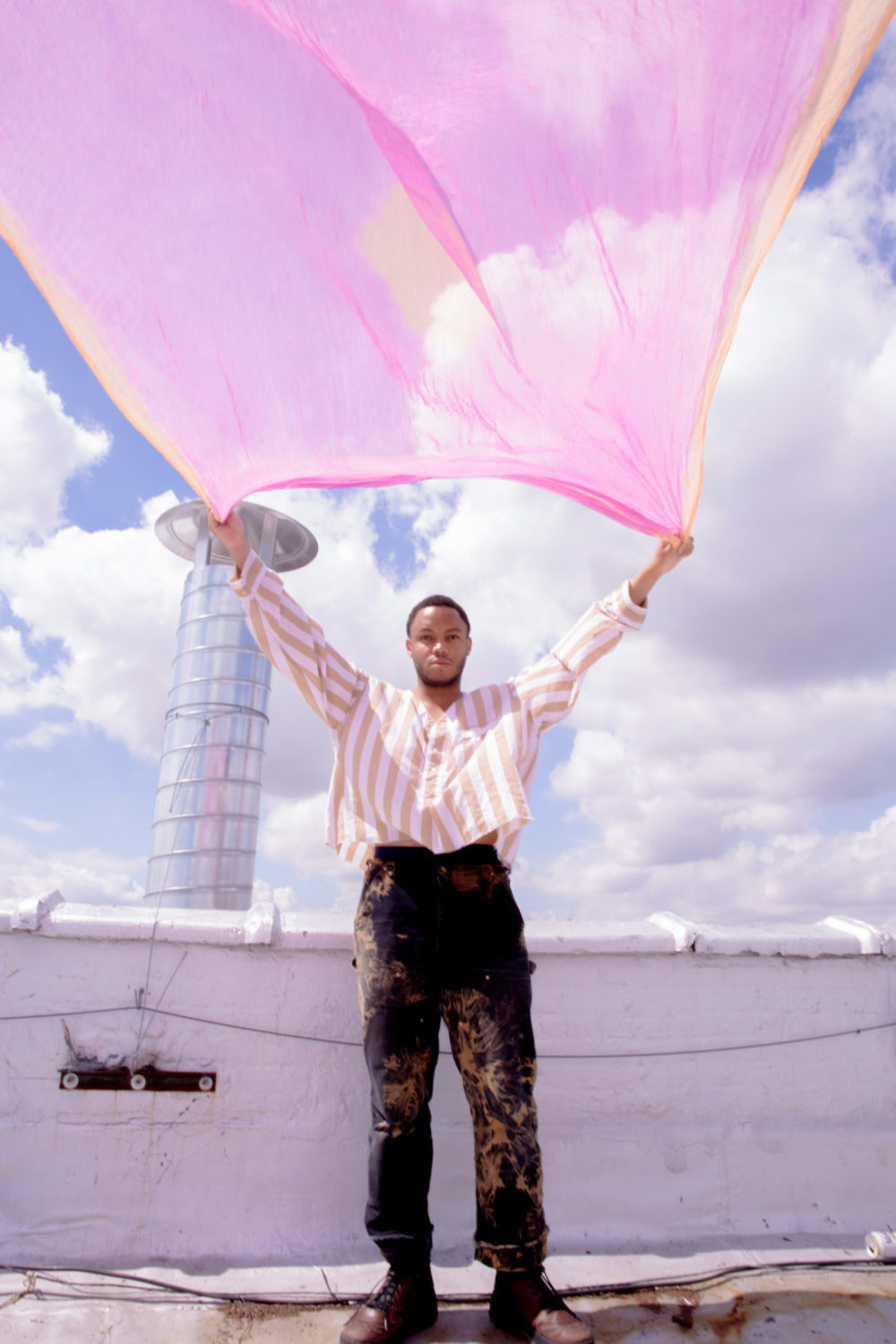
The first time I noticed an image in one of Mack’s paintings, it was of Prince. Parade (2016) remains a paradigmatic example of intertextuality in his work and one of its most arresting moments. The black-and-white image of Prince sits directly in the center of the work. At the time, I instinctively assumed it was his mugshot. It was not.
For a black celebrity, a mugshot has the Byzantine, palatial finality of a gong. Any image close enough to the form of a headshot falls into its centrifuge. Every image taken of that celebrity afterwards responds to it. That I, a black man, wandered into the Kunsthalle Basel and blithely assumed it was Prince’s mugshot is indicative of the form’s tragic ubiquity. The black mugshot is arguably America’s most popular genre of photography and the black celebrity mugshot its most extreme rarefication. The public reads the trajectories of Tiger Woods, Michael Jackson or James Brown through their respective plummets towards their mugshots, then their recoveries through images taken afterwards. Mugshots of black celebrities end up on t-shirts and coffee mugs, totems of a popular fixation with spectacular black failure following equally spectacular black success. The image of Prince at the center of Parade was close enough to his mugshot to be unavoidably linked with it. The work was marked by it, marked by Prince’s permed hauteur—“like this?” he must have asked when he lifted the placard, in his unmistakable, androgynous basso profundo. “No, not like that,” the officer on duty and aspiring portraitist must have replied before snapping the most perfect image in the history of that benighted genre.
It was this descent into apocrypha that opened the work up to me. In 1980, Prince and a friend were arrested in Jackson, Mississippi, for stealing an emergency megaphone from an airplane. A passenger witnessed the theft and alerted the pilot, who then grounded the flight and called the police. The megaphone was later discovered in Prince’s suitcase. Standing in front of Parade, I imagine that the suitcase fragment clinging to the same piece of tartan as Prince’s image speaks of that other suitcase, that perhaps they are the same suitcase. To Prince’s right, Mack has attached a folio page taken from a printing of Joseph Beuys: Multiples from the Reinhard Schlegel Collection (Mitchell-Innes & Nash, 2015). The page has a reproduction of a photograph We Won’t Do It Without the Rose (1972), depicting the artist speaking to a partially obscured interlocutor, presumably about the slender rose in the center of the frame. On the facing page, there is a “Works Illustrated” list for the missing book. In fact, Parade is not the only work of Mack’s that deals with the Multiples. In I don’t know your spirit. I make it up everyday from fragmentary portions (2016), Mack hung a dye-stained vintage coat and sweatpants directly from the gallery wall—a blown kiss to Beuys’s Filzanzug (felt suit) (1970).
The Multiples revolve around ideas of shelter and transience. They are suggestive of the artist’s body and refer to objects kept immediately on one’s person, such as umbrellas, canes and bags—things which recur throughout Mack’s oeuvre. The suitcase fragment in Parade operates as a through line in the work and pulls Prince into the same allusive orbit as Beuys. It takes me back to Kounellis’s imagined arrival in Venice and the doctor’s black satchel and the language of transience and movement that pervades Mack’s entire practice, not to mention that of Beuys. The bowler hat, the cane and the bag are central emblems of the twentieth century’s infatuation with rootlessness; I think of Samuel Beckett’s wandering, babbling indigents, Charlie Chaplin, and Giulietta Masina’s idle walks along Roman roads. The idea of the artist as a traveling shaman is a critical point in the work of Beuys and Kounellis, something that exists by implication in all of Mack’s work. The use of clothing always implies that someone, some tortured geometry, could somehow wear the work. All the fragments of a rootless life struggling to aggregate themselves into a house, a room, or a habitable plane.
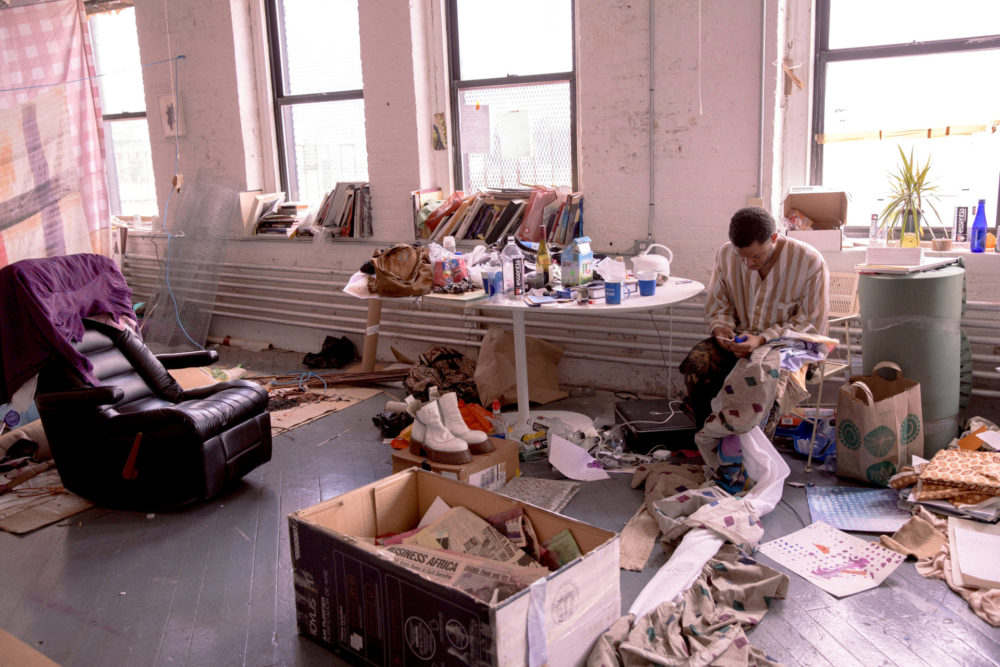
If rootlessness is one of modernity’s ur-themes, it takes on altogether different resonances in the hands of a black artist, for what are we but the dim, idle ephemera who have duckwalked like Chaplin on the periphery of the American dream for nearly four centuries? That suitcase fragment is not merely about travel; it is about migration, about the unstable, liquid identities that Mack’s aggregation of clothing and fabric imply. It is about Prince, on tour, with his entire life in suitcases, circumnavigating the country in the skies as his ancestors did on the ground. It is about Prince changing his name to a symbol and the unrestrained sexuality of the image on the wall. To evoke Glenn Ligon’s series of wanted posters, “Runaways” (1993), at this point is to descend into a referential fever dream so deep that only a poetic language of sense and no meaning can do it all justice. It is to wake from the dream and console oneself with the thought that it is just a suitcase fragment, not a madeleine; just a suitcase fragment, and no more.
The encounter between Prince and Beuys through the medium of that suitcase invests the rest of the materials (the fashion advertisements, the tartan, the newspaper pages, the curtain rod) with a certain magic energy, a shamanic quality, as if Parade were a mandala, a testament to an obscure personal religion that Mack in the guise of Prince has placed himself in the center of. Mack is somehow at the crossroads of Prince and Beuys, and Parade becomes a self-portrait. Importantly, the encounter of Prince and Beuys is not an encounter between equals: it is Prince that sits in the center of the image, it is Prince that gives the work its evocative force. Prince freaks Beuys, and in using him to do so, Mack does as well. It is jocular homage, reference dyed black, black the way that I am, black the way that he is, black the way that Prince is.
Moreover, Mack exploits the conventions of classical perspective to achieve this effect. The image of Prince sits in the narrative and geometric center of the work, the void into which all parallel lines disappear. The fundamental attribute of early constructed perspective was this very convergence. The same technique that gave the image what Masaccio or Giotto believed to be realistic depth was also the center point of the story. They converged at Christ’s chest, his navel, or in the hollow beyond a classical arch. In its earliest incarnations, a literal hole was poked in the canvas and string was used to produce the parallel lines that acted as training wheels for the image later to be drawn, then painted over. Even at the beginning of everything, there was sewing. Right at the origin of classical painting, there was a needle and thread, and fabric, and Mack knows it.
When I stand in front of Prince, I stand in the oculus. I say this with a certain anxiety, one born of a specific education that unmasked perspective as the child of a sinister Western imaginary. One that believed the world was subject to the same rules as a painting hanging on the wall of a Florentine villa or a staid Georgian townhouse in central London amidst banking ledgers and tribal masks. A painting was a bond, a form of guarantee that disciplining what one could see was also disciplining the things one couldn’t. The parallel lines on the surface of a canvas were also the lines of mercantile shipping routes from the metropole to the colonies, the lines of chained slaves marching on a sinuous anabasis to the Western coast of Africa, of longitude and latitude, the stripes left by the whip during the Inquisition, and the trajectories of ballistic missiles, of radar, of sonar, of bundled fiber optic cables that score the belly of the sea. Classical perspective was a viewing machine constructed for the edification of a white, European, male gazing subject. And the void in the canvas, that poked hole, was the void at the center of the construct, the emptied navel-gazing self that filled itself with the plunder of the world. Placing Prince right at the center of that apparatus, a pansexual pouting demi-God, an effigy to the protean creative energy of the black radical imagination, a dynamo at the center of the machine that renders the identity of every single one of its inhabitants unstable is an excessively, excessively radical gesture.
In A Lesson in Perspective (2017), Mack moves a live performer directly into the vanishing point. A gaping hole in the center of a suspended tent cover already demands that someone thrust their head through it. She wears the piece as a mantle, a caftan. The tension lies between her movement and the string of orthogonal paintings she forces to adopt the curvilinear forms of the body. It gives heightened poetic force to Prince’s haughty occupation of the center; one already hinted at in its title. This is one of Mack’s earliest efforts to add greater movement to his work, something more vivid than the faint rippling when people walk past or the grand gestures hinted at but left unrealized in its twisting stasis. In some of his other explorations of worn paintings, particularly his collaboration with Know Wave, he stages an encounter between the use of gridding and the free gestural play of marks and stains; the paint on a long sleeved shirt represents the collision between the grid of warp and weft in the fabric and the flourish of the cut. He assimilates the pas-de-deux of performer and A Lesson to the surface of a shirt.
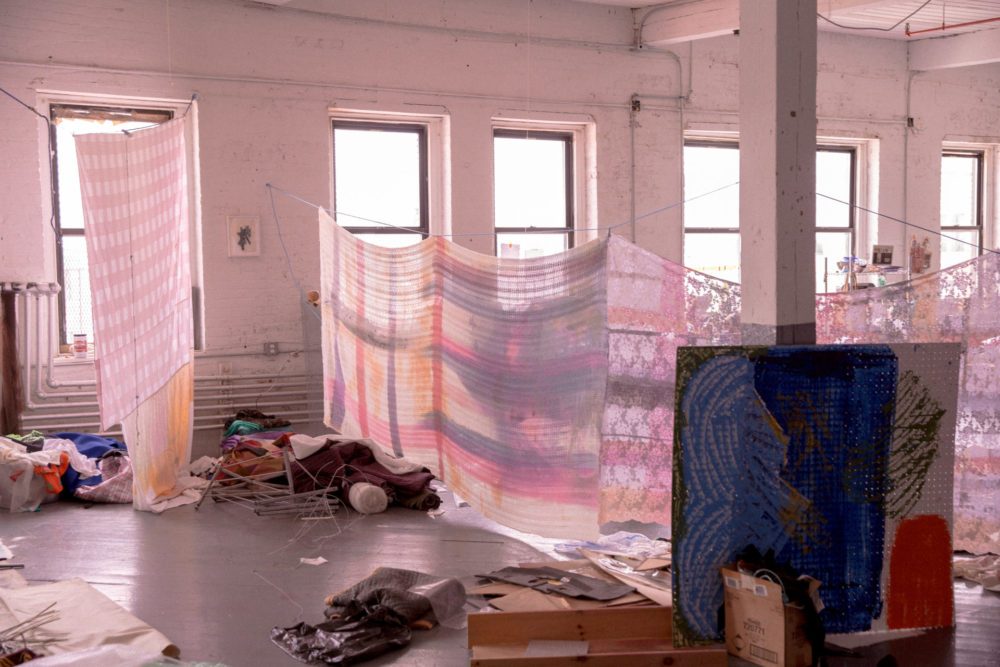
As an artist deeply informed by the emotional and narrative resonances of worn garments, it was always a matter of course that Mack would collaborate with the preternaturally gifted fashion designer Grace Wales Bonner, an artist who translates the dream songs of the diaspora into clothing. Dreams hauntingly familiar to those of us who have been born and raised in places we cannot completely call home. She is the inheritor of an artistic and intellectual milieu that does not often find its way into the hands of fashion designers, one passed down to her from figures such as John Akomfrah and Isaac Julien, Stuart Hall and Steve McQueen. There is none of the facile, foreign-correspondent orientalism we have come to accept as a matter of course from storytelling in fashion: the trips to Marrakesh and Fez, the waifish boy servant and indolent, oiled dark bodies, the shuffling geishas, the piled trunks, and Gisele in risqué safari outfit leading a pride of lions to a watering hole. Fashion has often expressed a mode of travel and acquisition that reached its apogee in the bustle of mercantilism. Bonner tells us the other stories; the ones about black royalty and romance, song, queerness both coded and resplendently on display. It is the shared belief in the possibilities of such stories that tether Mack and Bonner together. They both believe in thrusting Prince into the painting.
In her Autumn/Winter 2018 show, Bonner and Mack conjured up the world of Aimé Césaire’s Notebook of a Return To The Native Land and his endless lyrical perambulations between the cafés of the Ve arrondissement in Paris and the sands of Martinique. The infinite longing that began with a sigh seaward from the beaches of Ogygia, beneath Calypso’s black poplars, and followed the trade winds of history through invasion and conquest, beach and bivouac, to the pens of Caribbean poets like Walcott and Césaire, who sighed back. Mack suspended a series of semi-transparent, colored silks and linens subdivided into vertical and horizontal stripes reminiscent of Rauschenberg’s “Jammers” in their frailty and transparency. However, he draped these along skewed trajectories. They stretched from ceiling to floor and framed the trail of models and their garments. The largest painting is held precariously on one side, as precariously perhaps as the solitary button that holds one of Bonner’s single-breasted black jackets together. Mack makes an effort to dematerialize the supports: cords are thin and used sparingly; things are left to take on the shape that gravity gives them. This effort finds its counterpoint Bonner’s nautical symphony of buttons; for her, the fasteners are profligate and in some cases, wonderfully, poetically superfluous.
Mack’s drapery recalls the buffeting sails of small fishing boats. The models walked through a realm of romantic exile: a group of men stepping off the steamer from Calais onto a catwalk at Fort-de-France mere months after graduation from the Collège de Droit, dispatched to serve in the provisional government of a colony they were born into, at once happy to be home and aware that the island is home no more and perhaps never was. Mack knows the allusive capacities of large-scale fabric paintings to leverage the architecture around them to speak of other places. It is somehow fitting that their show took place in the piano nobile of a Grosvenor Place townhouse, a place I cannot help but associate with polished white columns, a Handel concerto, restrained murmuring, and in the other room, “over there,” the violent vivisection of the world.
Among the most enduring of all sentimental myths about Washington D.C. is the belief that it is a microcosm of America. We have ground these narratives to a fine powder: the tale of two cities, one white and the other black, as divided as the nation that contains them; the city on the hill and sprawling oblivion of its suburbs; the moral and ethical laxities of K Street and the highly rarefied codes of conduct on the streets of Southeast. We have read Joan Didion and Edmund Wilson, James Baldwin and Lionel Trilling. We know that D.C. is the space of very specific, very American projective fantasies. Yet for those of us who have lived there, who know the winds that blow through it from Jamaica and Trinidad, Ethiopia and Somalia, the foehn winds that mute, frustrated families carried with them on crowded buses from Selma and Montgomery, Jackson and Baton Rouge, en route to permanent exile from the places where the barricades stood then broke, D.C. is something anecdotal, personal, and black. It is one of the secret quilting points of a global black imaginary.
It is also incidentally the space in which Eric N. Mack and late-‘90s stylist Misa Hylton-Brim converge. Even while working with Missy Elliot, Lil’ Kim, Mary J. Blige, and Puff Daddy in New York, it was always towards D.C., one of the largest markets for black media in the country, that Bad Boy Records and its gifted stylist turned. D.C. was the terminus of an underground railroad of fashion and music that started in Harlem and ended in places like The Ritz, a black-owned nightclub that crouched in the shadow of the FBI Headquarters, or Howard Homecoming and the waving regalia of Georgia Avenue during Carnival every summer. Hylton-Brim turned towards the D.C. of black owned fashion brands—of Rugid Wear and Da Link Went, Hobo and We R One. And perhaps, towards a young boy in a house in Capitol Heights in the early 2000s and the slow accumulation of laundry on his bedroom floor; the posters that lost their adhesion and fell, and were left there; clothing pulled from the crevices of living room sofas while BET cycled from Rap City to 106th and Park indifferently in the background.
In “Misa Hylton-Brim,” Mack’s 2018 solo exhibition at Simon Lee Gallery in London, he refers in some penumbral way to this world. The works are less a direct engagement with the music videos Hylton-Brim worked on or the celebrities she dressed than the remains of media through which her work was disseminated and his memories of the domestic sites in which they were collected. He refers to a time in the past, but glimpsed through the loose allusiveness of the Internet era, things fragmentary and jumbled co-existing at the same time and in the same place. These are ballads of the black mundane, not the grand oratorical flourishes of stage and pulpit. Mack’s poetics have the supernal allusivity of gifted raconteurs, of people who have a special gift for association and stage their gifts during the exchanges of everyday life. His is a conversational poetry of voices around kitchen tables that won’t stop their chatter and the silent child that appears not to be listening, but hears everything.
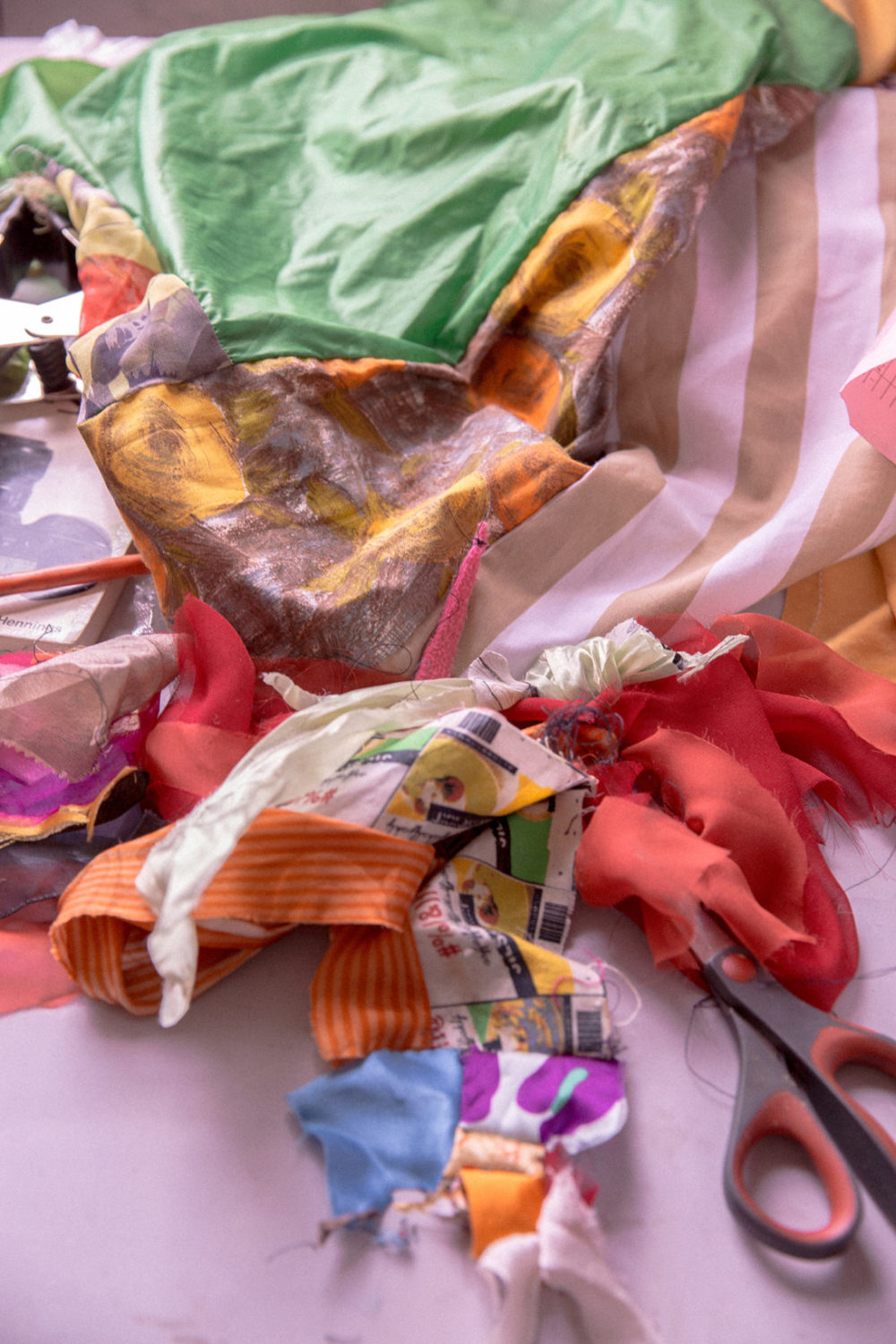
The works in “Misa Hylton-Brim” sustain a vibe, an exact sense, a static electricity that leaps from work to work. No effort to decompose any of the works into their constitutive parts or to work additively enables a gestalt reading. A composition without any images at all, such as Untitled (2018), remains equally capable of speaking to those sites of memory as (Menagerie) The Thorn/The Veil/The Fall of Grace (2018), a work literally overcoded with images. Moreover, the abstract grammar of fabric and overlapping planes of color do not exist in isolation from the appropriated imagery. One does not, as it were, read Misa Hylton-Brim in the images and then Mack, the painter, in the marks or formal gestures. The images participate in the abstract roulette. They themselves are painterly marks, representational participants in the relay between all of the compositional elements.
In (Menagerie), the moving blanket acts as the ground and support against which the dye and images register themselves. The square frame foregrounds the images of Mary J. Blige, Susan L. Taylor, and Lil Wayne; it draws attention to the dye and parquet stitching of the blanket. Again in The Brazen Image/The Thief of Sleep (2018), the relay between the moving blanket fastened securely to the wall and the splayed, spreading form of the sateen blanket generates a formal tension, a contrapposto that pulls the acrylics and the stray, pouting handkerchief into relief. The recurrence of the moving blanket from work to work ties all of the compositional elements into a single narrative frame. The images and smaller elements are pinned in paintings as stones set in a diadem. Together they form orthogonal patterns, anguished grids, reminiscent of minimalist abstraction.
The sense that the stunned faces of black celebrity vanish into the relentless logic of painterly abstraction recalls Parade and Prince’s manic energy. Hylton-Brim stands her full height during these encounters, in the collision between black febrile creativity and a tradition of Western representation that simultaneously foregrounds and excludes it. At one time, Hylton-Brim dressed some of the most famous celebrities on the planet, styling red carpet, editorial, and magazine covers. One should ask oneself if Versace would be Versace without Hylton-Brim and Diddy—or if Diddy would be Diddy, for that matter. Yet, she remains largely unknown outside a coterie of black ephemera aficionados and 1990s fashion revivalists. In staging an encounter between certain images marked by her and a highly idiosyncratic abstract language saturated in the history of art, Mack’s paintings re-perform one of the rubs at the heart of the black artistic experience in this country. They remind us that abstraction—the very act of abstracting itself—involves erasure as much as sublimation; of the belief that all the arts aspire to the condition of music because up there, on the slopes, on an alpine meadow, there is light, color, and form rather than race and theft; and that every garden, every Edenic landscape, conceals a crime. A vanishing point in the center of Arcadia. Washington, D.C. is one such garden, and Mack has moved Hylton-Brim, like he did with Prince, into the pinhole. And the image of Mary J. Blige staring out at us from (Menagerie), an exhortation from a pleat in a combine, is a reminder of the divine potential of abstract painting when one puts the black back into it.
